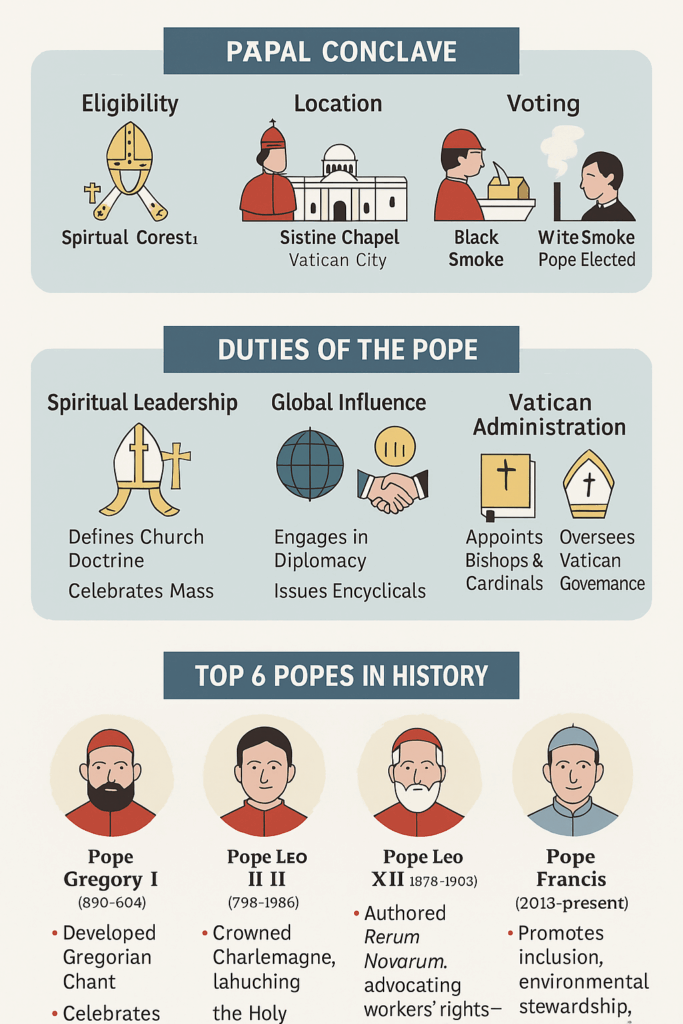The Pope is one of the most recognizable religious figures in the world. As the spiritual leader of the Roman Catholic Church—a faith with over 1.3 billion followers—the Pope holds immense religious, cultural, and even political significance. But who exactly is the Pope? How did this role originate, what are his duties, and why does he continue to play such a powerful role in global affairs?
In this comprehensive blog post, we’ll explore the history, responsibilities, and influence of the Pope. We’ll also delve into the election process, major achievements of past Popes, and even some of the controversies that have shaped the papacy throughout the centuries.
Who Is the Pope?
He is the Bishop of Rome and the head of the worldwide Roman Catholic Church. Regarded by Catholics as the successor to Saint Peter—one of Jesus Christ’s twelve apostles—the Pope is considered the Vicar of Christ on Earth. His authority is supreme in matters of Church doctrine and governance.
He also serves as the head of Vatican City, an independent city-state surrounded by Rome, which functions as the spiritual and administrative center of Catholicism.

When Was the First Pope Elected?
The title of the first Pope is traditionally attributed to Saint Peter, who lived in the 1st century AD. According to Catholic tradition, Jesus appointed Peter as the leader of his disciples. Peter later traveled to Rome and was martyred there around 64 AD under Emperor Nero.
While the term “Pope” wasn’t used in its current form until centuries later, Peter is recognized as the inaugural holder of the papal office. The official list of Popes begins with him, followed by Pope Linus and Pope Anacletus.
📌 A horizontal timeline:
Francis (2013–present)
Saint Peter (1st Century)
Constantine and legalization of Christianity (313 AD)
Avignon Papacy (1309–1377)
Protestant Reformation (1517)
Vatican I (1869–1870)
Vatican II (1962–1965)
Pope John Paul II (1978–2005)
How Is the Pope Elected?
Popes are elected by a Conclave—a secretive meeting of the College of Cardinals—following the death or resignation of the current Pope. The voting process takes place in the Sistine Chapel, behind closed doors.
The Papal Election Process:
- Only Cardinals under the age of 80 can vote.
- A two-thirds majority is required for election.
- After each vote, ballots are burned. Chemicals are added to produce black smoke (no decision) or white smoke (elected).
- Once a Pope is chosen, he is asked if he accepts the role and what papal name he wishes to use.
What Are the Duties of the Pope?
The Pope has both spiritual and administrative responsibilities. These include:
- Defining Church doctrine.
- Appointing bishops and cardinals.
- Serving as a moral voice on global issues.
- Leading global Catholic efforts in education, charity, and diplomacy.
- Writing encyclicals (papal letters guiding doctrine).
- Conducting Masses and international religious ceremonies.
He also represents the Catholic Church on the world stage, often engaging with political leaders, religious figures, and humanitarian efforts.
Achievements of the Popes: Milestones Through the Ages
Despite centuries of challenges—from schisms to scandals—the papacy has overseen major achievements that shaped not just the Church, but global history.
1. Pope Gregory I (r. 590–604)
- Codified liturgical practices.
- Initiated missionary work to convert Anglo-Saxons in England.
- Instituted Gregorian Chant.
2. Pope Leo III (r. 795–816)
- Crowned Charlemagne as Holy Roman Emperor, intertwining Church and State for centuries.
3. Pope Urban II (r. 1088–1099)
- Launched the First Crusade, urging Christians to reclaim Jerusalem. A deeply controversial but pivotal event.
4. Pope Leo XIII (r. 1878–1903)
- Authored Rerum Novarum, advocating for workers’ rights—an early Church endorsement of social justice.
5. Pope John Paul II (r. 1978–2005)
- Instrumental in ending communism in Eastern Europe.
- Visited over 100 countries, promoting interfaith dialogue.
- Canonized hundreds of saints and modernized Church outreach.
6. Pope Francis (r. 2013–present)
- Advocates for climate action, refugee support, and social inclusivity.
- Known for humility and simplicity—he resides in a modest guest house instead of the Apostolic Palace.
Controversial Popes and Criticism
Not all papacies have been virtuous. Some Popes have been at the center of corruption, scandal, and abuse.
1. The Borgia Popes
- Pope Alexander VI (r. 1492–1503) is infamous for nepotism, sexual affairs, and political manipulation.
2. The Avignon Papacy (1309–1377)
- A period where Popes resided in France, seen by many as political puppets of the French monarchy.
3. The Inquisition
- Several Popes oversaw or endorsed the brutal suppression of heresy during the Inquisition, leading to widespread persecution.
4. Sexual Abuse Crisis
- In recent decades, the Church has faced global criticism for the handling of child abuse cases. Though recent Popes have introduced reforms, critics argue it’s not enough.
Modern Political and Social Influence
Today, the Pope continues to be a major global influencer, not just in religion but in politics, science, and humanitarian affairs.
Pope Francis and the Modern World
- Climate Change: His 2015 encyclical Laudato Si’ calls for urgent environmental action.
- LGBTQ+ Rights: While upholding traditional Church teachings, Pope Francis has shown unprecedented openness, saying, “Who am I to judge?”
- War and Peace: Regularly denounces conflicts (e.g., Ukraine, Gaza) and advocates for diplomacy.
- Vaccines and COVID-19: Promoted public health and vaccine equity during the pandemic.
The Pope’s Role in a Changing World
Whether seen as a spiritual guide, a moral compass, or a controversial figure, the Pope remains a central figure in global affairs. As head of one of the world’s oldest institutions, he bridges tradition with modernity, often walking a tightrope between doctrine and reform.
In a world of constant change, the papacy endures—not only as a symbol of faith but as a mirror reflecting the triumphs and struggles of humanity.
Curious about how other major religions compare in leadership structure and influence? Stay tuned for our next piece in this religion-focused series, where we’ll explore the role of religious leaders in Islam, Judaism, and Eastern traditions.


